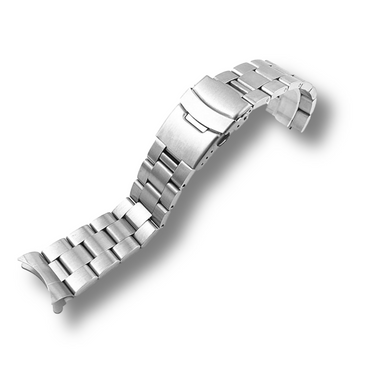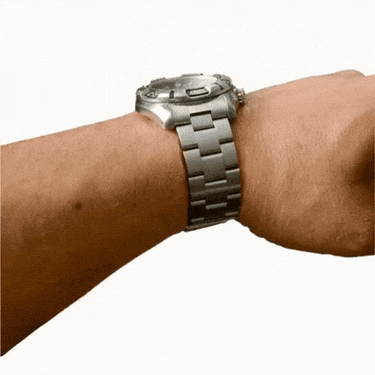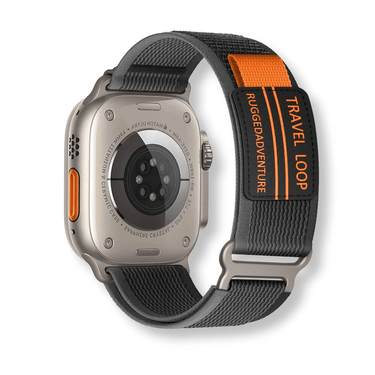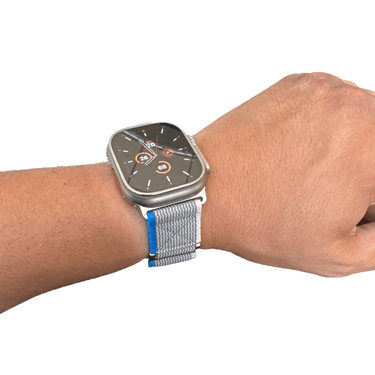The Importance of Maintaining a Watch
Watches are more than just accessories. They are precision machines that require care and attention to function properly.
Neglecting to maintain your watch can lead to inaccurate timekeeping, damage, and even complete failure. Yet, many people seem content with treating their watches as disposable items – wearing them until they stop working and then simply buying a new one.
This is unacceptable. Just like any other valuable possession, your watch deserves proper care and maintenance.
Not only does it help preserve the integrity of the timepiece, but it also ensures that you get the most out of your investment. So, if you're guilty of neglecting your watch or think it's not worth the hassle, think again.
The Role of Turns Per Day in Keeping a Watch Running Smoothly
One crucial factor in maintaining a watch is ensuring that it runs smoothly and accurately. This is where turns per day come into play. For automatic watches (which make up the majority of high-end timepieces), turns per day refer to how many rotations the rotor needs to keep the mainspring fully wound.
If an automatic watch isn't wound enough or is over-wound, it can lead to decreased accuracy, reliability issues, and even damage to the movement itself. The number of turns per day needed depends on several factors including the type of movement (automatic or manual), brand and model of the watch, wearer's activity level, among others.
Therefore, understanding how many turns per day your specific watch needs is crucial for maintaining its accuracy and longevity. It's not enough just to wear your watch daily – you need to ensure that it's being wound properly as well.
Conclusion
Owning a quality timepiece comes with responsibilities beyond just wearing it on your wrist. These watches require proper care and attention to function optimally, and it's essential to understand the role that turns per day play in ensuring accurate timekeeping. So, before you give up on your watch and toss it aside, take a moment to consider the time and effort that went into creating it.
Treat it with respect and give it the attention it deserves. Trust me; your watch will thank you in return with years of reliable timekeeping.
The Importance of Turns Per Day for Your Watch
What are turns per day?
Let's start with the basics. Turns per day (TPD) refers to the number of times your watch needs to be wound in order to keep it running smoothly. This is especially important for automatic watches, which depend on the natural movement of your wrist to wind the mainspring and power the watch.
The TPD required for your watch will depend on several factors, including the brand and model of your watch, as well as your own activity level. Some watches may require as few as 300 TPD, while others may need up to 1,000 TPD or more.
How it affects the accuracy of your watch
Now that we know what TPD is, let's talk about why it's important. The number of turns per day your watch needs can have a big impact on its accuracy and reliability.
If your watch isn't wound enough, it may start running too slowly or stop altogether. This can be especially frustrating if you rely on your watch for important events or activities.
On the other hand, if you wind your watch too much, you run the risk of damaging the mainspring or other components of the movement. This can lead to costly repairs and potentially even render your beloved timepiece useless.
Finding the right TPD for your specific watch is crucial for maintaining its accuracy and longevity over time. So don't skimp on winding - give that beauty some love and keep her ticking smoothly!
The Elusive Turns Per Day
Winding your watch is a crucial step in ensuring its accuracy and longevity. But just how many turns per day does your watch need? There is no one-size-fits-all answer to this question, as the number of turns per day needed varies based on several factors.
Type of Movement Matters
The type of movement in your watch plays a significant role in determining how many turns per day it needs. Automatic watches, for instance, rely on the wearer's movement to keep time, meaning that the more active you are during the day, the fewer turns per day your watch will need. On the other hand, manual watches require manual winding every 24 to 48 hours to keep them running accurately.
Brand and Model Considerations
Different brands and models of watches have different power reserves and may require varying numbers of turns per day. For example, a vintage Rolex from the 1950s may need 650 turns per day to maintain accuracy since it has a lower power reserve than modern models. Similarly, some luxury brands like Patek Philippe have movements that require less than 200 turns per day.
Activity Level Plays a Role
The activity level of the wearer also affects how often they need to wind their watch. If you're an athlete or someone who engages in strenuous physical activities daily, then you don't have to worry about winding your automatic watch often since your body movements will suffice in keeping it running accurately.
Recommended Range for Different Types of Watches
Generally speaking, most automatic watches require between 400-800 TPD (turns per day), while manual watches usually demand around 10-15 winds every morning or evening. However, some high-end luxury brands like Rolex can go up to two days without being wound before losing time, while others like Omega require winding every day.
The number of turns per day your watch needs depends on several factors. Understanding these factors and taking care to wind your watch as needed will help ensure its longevity and accuracy.
So, take the time to figure out how often your watch requires winding and don't be afraid to ask for help if you're unsure. After all, a little attention today can go a long way in keeping you on time for years to come!
The Consequences of Not Winding Your Watch Enough
Winding your watch is a crucial part of owning a mechanical timepiece. It is necessary to ensure that the watch remains accurate, reliable, and continues to function for an extended period. Failing to wind your watch enough can have serious consequences that will affect not only its performance but also its longevity.
Decreased Accuracy and Reliability
One of the most significant consequences of not winding your watch enough is decreased accuracy and reliability. A mechanical watch relies on a delicate balance between the mainspring's tension and resistance to keep accurate time. When you fail to wind it enough, the mainspring will lose tension, resulting in erratic behavior in timekeeping.
Accuracy is critical for any timepiece, but it becomes even more essential if you rely on your watch for activities that require precision timing. If you wear your mechanical watch while competing in sports events or during scientific experiments requiring precise measurements, the consequences of not winding it enough can be disastrous.
Potential Damage to the Movement
Another consequence of not winding your watch enough is potential damage to the movement itself. The motion works within a mechanical watch are incredibly intricate and delicate – they require frequent use and maintenance to remain in good working order. When you neglect winding up your mechanical watch regularly, it can cause dirt or debris buildup within its internal components or cause unnecessary friction between different parts.
This friction may result in wear and tear over time and potential damage that could lead to costly repairs or replacement. Owners must be mindful about maintaining their watches by winding them up frequently to ensure their continued accuracy, reliability and minimize wear while keeping them well lubricated with oil changes every few years or so depending on how often one wears their piece during different seasons throughout each year!
The Consequences of Winding Your Watch Too Much
Increased Wear and Tear on the Movement
Winding your watch too much may seem like a good way to ensure that it keeps ticking, but in reality, it can do more harm than good. The movement of your watch is a complex system of gears, levers and springs that work together in harmony to keep time accurately.
When you wind your watch too much, you put unnecessary stress on these delicate parts, which can lead to increased wear and tear. Over time, the added strain from over-winding can cause parts to break or become misaligned, throwing off the accuracy of your watch.
The mainspring, for example, may become overstretched and lose its ability to provide consistent power to the movement. This can result in erratic timekeeping or even a complete failure of the watch.
Potential Damage to the Mainspring
The mainspring is one of the most important components in a mechanical watch. It is responsible for storing energy from winding and releasing it slowly over time to power the movement. When you wind your watch too much, you risk damaging this critical part.
Over-winding can cause the mainspring to become overstretched or even break altogether. This not only affects the accuracy of your watch but also makes it difficult or impossible to repair without costly repairs.
It's important to note that while some watches are designed with safety mechanisms that prevent over-winding, not all watches have this feature. It's up to you as the wearer to be aware of how much you're winding your watch and take precautions accordingly.
The Bottom Line
Wearing a mechanical watch requires understanding how winding works and how much winding is necessary for optimal performance. Over-winding can cause significant damage that could affect not only timekeeping but also costliness repairs down the line. It's important to pay attention to the recommended turns per day for your specific watch and avoid winding it excessively.
In the end, proper care and maintenance are key to ensuring that your watch runs smoothly for years to come. So next time you reach for your favorite timepiece, remember that a little knowledge and care can go a long way towards keeping it ticking like new.
How to Determine How Many Turns Per Day Your Specific Watch Needs
Now that we've established the importance of knowing how many turns per day your watch needs, let's talk about how to determine this magic number. While there are a few different methods, the easiest and most accurate way is to consult your watch's user manual or contact the manufacturer.
If you're like me and have long since lost your watch's manual, fear not. You can also do some simple tests at home to get a rough idea of how many turns per day your watch needs.
Start by winding it fully and wearing it for a day or two while keeping track of its accuracy. If it gains or loses more than a few seconds per day, you may need to adjust the turns per day accordingly.
Another method is to use a watch winder that allows you to program the number of turns per day. While this is a convenient option for those with multiple automatic watches, keep in mind that not all winders are created equal and some may not be compatible with certain brands or models.
Tips for Measuring
When measuring how many turns per day your watch needs, there are a few important tips to keep in mind. First and foremost, make sure you're using an accurate timepiece as a reference point. This could be a quartz watch or even your smartphone set to atomic time.
Next, ensure that you're measuring over an extended period of time – ideally several days or even weeks – as small variations in accuracy can add up over time. Try different positions and activities while wearing your watch (such as sleeping versus exercising) as this can affect its accuracy and therefore its turning requirements.
Common Mistakes To Avoid
While determining how many turns per day your specific watch needs isn't rocket science, there are some common mistakes that people make which can lead to inaccurate or even damaging results. One of the biggest mistakes is assuming that all automatic watches require the same number of turns per day, when in fact this can vary widely based on a number of factors. Another mistake to avoid is over-winding your watch, which can put undue stress on the movement and potentially cause damage over time.
To prevent this, always pay attention to how much resistance you feel when winding your watch and never force it beyond its natural stopping point. Be wary of generic advice or anecdotes from others about how many turns per day their own watches need.
While these can be helpful as a starting point, ultimately every watch is unique and requires its own individualized care and attention. Don't be afraid to consult with a professional or do your own research to ensure you're giving your timepiece the care it deserves.
Conclusion
The Importance of Proper Maintenance for Long-Lasting Timekeeping
In this day and age, most people resort to technology to tell time. However, for some, watches are more than just an accessory; they represent a part of their personality or symbolize their status.
Therefore, it is essential to maintain your watch properly to keep it running for years to come. Neglecting even the smallest aspect of maintenance can cause severe damage to your watch's movement and, ultimately, lead to costly repairs or replacement.
A fundamental part of maintaining a watch is ensuring that it receives the correct number of turns per day. As I've pointed out in this article, whether you have an automatic or manual timepiece and how active you are will dictate the number of turns required.
Failing to wind your watch enough will result in decreased accuracy and potential damage to the movement. Conversely, winding it too much is just as harmful as it can put unnecessary wear and tear on the mainspring.
Final Thoughts on Turns Per Day
Determining how many turns per day your watch needs might appear challenging at first but can be accomplished with ease by following a few simple steps. Neglecting this task will result in decreased accuracy and potential damage that could affect your timepiece's longevity significantly.
However daunting or tedious it may seem initially, taking care of your mechanical watch is well worth the effort in ensuring its long-term health and reliability. Remember that a high-quality watch isn't merely another gadget—it's an investment piece that requires proper care and upkeep for optimal performance and longevity.
While newer technologies offer convenience when telling time, there's no substitute for the craftsmanship involved in creating a mechanical masterpiece such as a wristwatch. With care and attention paid towards keeping your timepiece running smoothly through careful maintenance—including giving it enough winding—there's no limit to how long your watch can keep ticking.

























